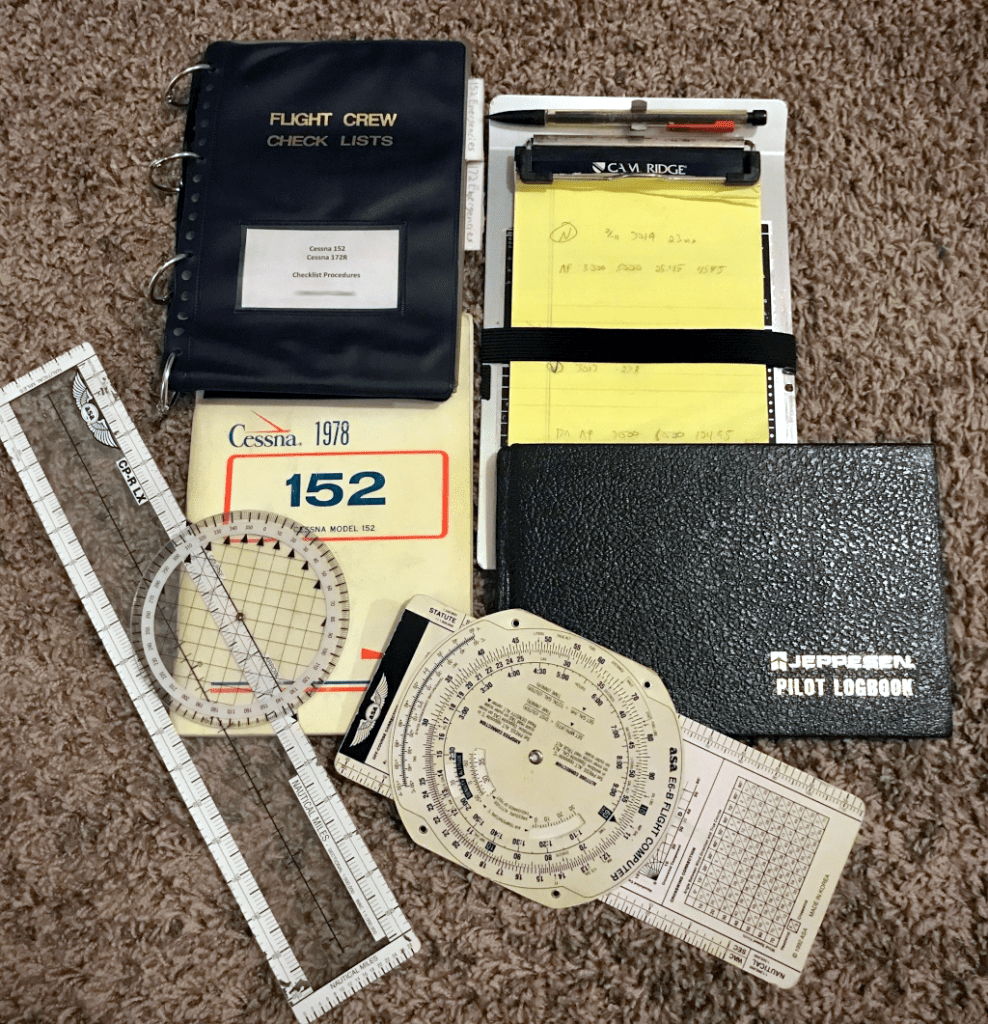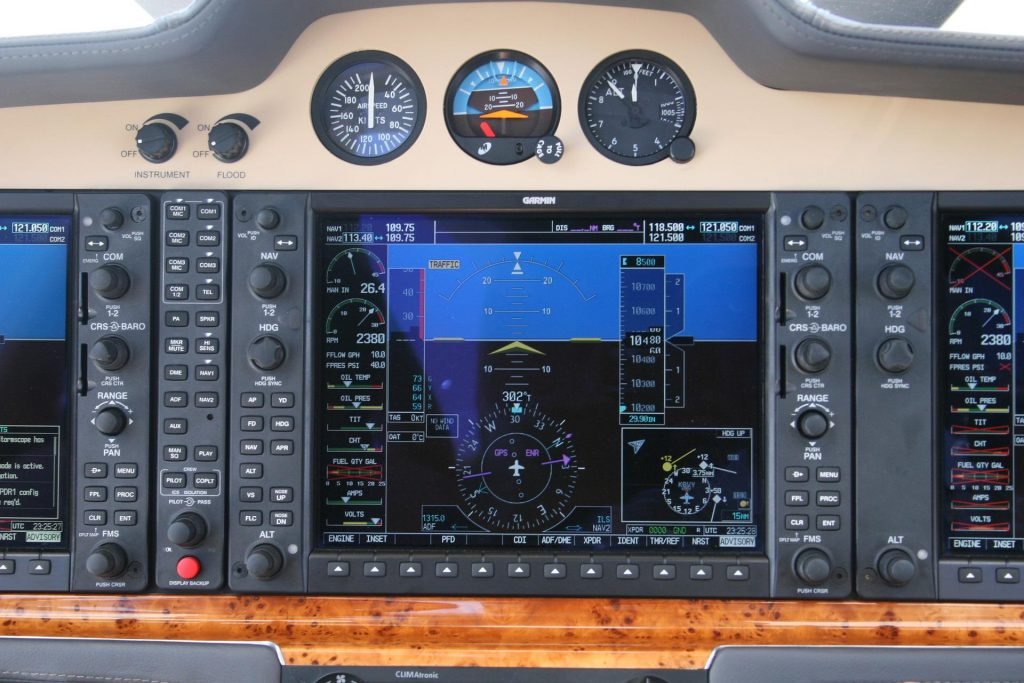There are various things a student pilot needs to get started with their flight training. Other than motivation and a positive attitude, these are the necessities needed to start flying.
Here, take a look at some accessories I pulled out of my flight bag.
Most of these are absolute essentials, but I threw in a couple of items at the bottom of the list as options. These are arranged in any order of importance. Enjoy!
Table of Contents
Headset
Every pilot needs a headset. Those piston engines aren’t exactly quiet, and it’s loud inside that cockpit. You need a headset to listen and talk to air traffic controllers (ATC), but also to protect your hearing. The headset I used was excellent. It had gel cups around the ears to drown out the sound of the engine very well and was a pleasure to use. It was the David Clark H10-13.4. It’s a fairly popular model. Check it out if you want!
Flight Bag
A flight bag is where you can put all of the items discussed in this article. I started out with a junky pleather type of bag when I began my training, but soon as it started to fray I realized I needed something of higher quality. I then got a nice, heavy-duty bag from Sporty’s and it hasn’t failed me. I usually take it with me on every flight, and it has all my goodies in it.
Pilot’s Operating Handbook (POH)
The Pilot’s Operating Handbook, or “POH,” tells you everything you need to know about the aircraft from a pilot’s perspective. In the POH you’ll find appropriate checklists for operation, information on the systems, performance, weight & balance, and anything else that pilots need to know for operating the aircraft. It’s a sort of “home base” of information for pilots regarding the aircraft they’re flying.
Kneeboard
A kneeboard is a small clipboard with a pen/pencil holder that you strap around your leg in the cockpit. It is needed any time you have to write things down in the aircraft. Usually, this is ATIS information, weather information, squawk codes given by ATC, or anything else you feel like you need to jot down while flying.
This will become more essential when copying IFR clearances if or when you decide to pursue an instrument rating, but it’s still important to have for cross country flying while VFR and around the terminal area of controlled airports.
E6B Flight Calculator & Plotter
I put these together because they are both needed for planning your navigation on cross-country flights. The E6B is a device that is used to calculate ground speed for a flight, among many other things. These are sometimes called a “whiz wheel” and can possibly be replaced by an electronic flight calculator.
I would, however, recommend all student pilots pick one up or order one just to learn how to use it. There are little lessons you learn when you use them that help you contextualize what you are doing.
The plotter is a protractor of sorts, for pilots. It’s used to draw accurate lines on a map to plot out your course. Again, in the digital age we live in, these will become less necessary, but I still recommend pilots pick them up for good old fashioned dead reckoning skills.
Logbook
Every pilot needs a good logbook. You need it to log flight hours while pursuing your certificates and ratings. Get a good one from Jeppesen or Sporty’s. There’s not much else to be said. You gotta have one!
Maps/Charts & Airport Facility Directory
A VFR pilot will need to know how to read a sectional chart (map). Although you may eventually graduate to some sort of app or flight planning software on an iPad, it’s important to get a physical copy of a sectional chart. That way you can study the symbols, memorize them, learn how to read one, and have one with you in the airplane as a backup to your digital device.
Another important booklet to have is an Airport/Facility Directory (A/FD.) I always carried one of these in the cockpit with me along with the sectional map. It tells you detailed information about the airports that you will fly to, as well as information about fuel, runway distances, and anything important that you should know before visiting an airport.
The A/FD is also important if you’re cruising along on a cross country flight, and feel like stopping at a small, unfamiliar, $100 hamburger type of airport for a bite to eat. You can check to see what type of facilities to expect when you touch down and taxi to the ramp.
Educational Books & Courses
Although you can get the FAA publications online for free, it’s not a bad idea to purchase physical copies of the Airplane Flying Handbook and the Pilot’s Handbook of Aeronautical Knowledge. Those are the two essential books for any prospective private pilot to have.
There are also many great video/interactive courses that are available online, or in DVD format nowadays. It’s not a bad idea to invest in a good course. The courses from Sporty’s or the King Schools are great.
Fuel Strainer
You’ll need to check the fuel for contaminants before every flight. A fuel strainer/tester is how that is accomplished. Gotta have it! It could save your life 😉.
Light for Night Flights
Before your checkride you’re going to be doing some night flying. It’s required for a Private Pilot. A good flashlight is important for your preflight checks on the exterior of the aircraft in the dark, especially if you’re parked on a dark ramp with no outdoor lighting.
It’s also important to have a red light inside the cockpit and reading maps. This may be two separate lights or one light that has a red filter to put on the light source.
While flying at night your eyes see objects differently. A red light is recommended for reading charts and maps inside the cockpit because it does not severely interfere with your night vision or ability to spot objects outside your window at night as white light does.
Foggles / View Limiting Device
Before you can take your checkride for your Private Pilot Certificate, you need to have at least three hours of flying solely by reference to instruments. The way to accomplish that is to use a view limiting device.
These can come in the form of a “hood” type of contraption or something we call Foggles. Foggles are glasses that are blurred out except the bottom corner closest to your nose so all you can see is the instrument panel.
From personal experience, I would not recommend Foggles because they make it too easy to cheat. My experience with Foggles told me I could easily see outside the cockpit with my peripheral vision, thus giving me a crutch. A crutch you don’t have in IMC!
Your instructor may disagree but that’s my humble opinion. A hood looks goofy and isn’t as comfortable, but you’ll be a better instrument pilot because of it.
Checklists / Checklist Sleeves
As I mentioned earlier, every POH comes with checklists for the aircraft you’re flying. You can also purchase premade checklists for most general aviation training aircraft. However many pilots, including myself, like to customize their checklist and add tasks that aren’t in the standard checklist for the aircraft.
If you like to include extra items in your checklist you’ll have to print out your own and use a booklet with plastic sleeves to hold the papers. It’s kind of a pain to create customized checklists and put them inside the sleeves but it’s entirely worth it when you’re in the cockpit and know you have all your bases covered.
Just make sure you don’t leave anything out of the checklists in the POH! I discovered that creating my own, customized checklists to be one of the more satisfying tasks of learning to fly. Take pride in your checklists. Pilots basically live or die by them!
Sunglasses
I saved the coolest item for last. I mean what pilot in their right mind would not sport a slick pair of aviator shades? 😎
In all seriousness sometimes that sun does get in your eyes and it’s a good idea to have a good pair of shades. I would highly recommend that you get a nice pair for yourself. A nice pair of aviator shades will provide benefits inside and outside the cockpit.
Optional Items
Here are some things that aren’t necessarily required. But you may elect to fly with these items for added safety or comfort.
Handheld Radio
A backup handheld VHF radio is always a good item to have in the cockpit with you. I purchased one and carried it with me in my flight bag, but luckily I never had to use it. However, if I did find myself with a two-way radio communication failure around a busy airport I would be thanking my lucky stars that I had it with me. Consider getting one!
iPad, Apps, & Accessories
Many pilots these days are flying with iPads. When I was a student pilot, this was not an option. Times have changed.
If you decide to go the route of flying with an iPad obviously you’ll need the necessary equipment to keep it charged and keep it mounted somewhere inside the cockpit. This is assuming the airplane you’re flying doesn’t already have these items. If you rent an aircraft, it may already have everything you need. It depends on where you fly.
Conclusion
These 13 items are all the things that a student pilot should have before starting flight training. If you’re interested, I have another article where I estimate all the expenses of becoming a Private Pilot.
Okay, did I leave anything out? Let me know in the comments below. Thanks for reading!



